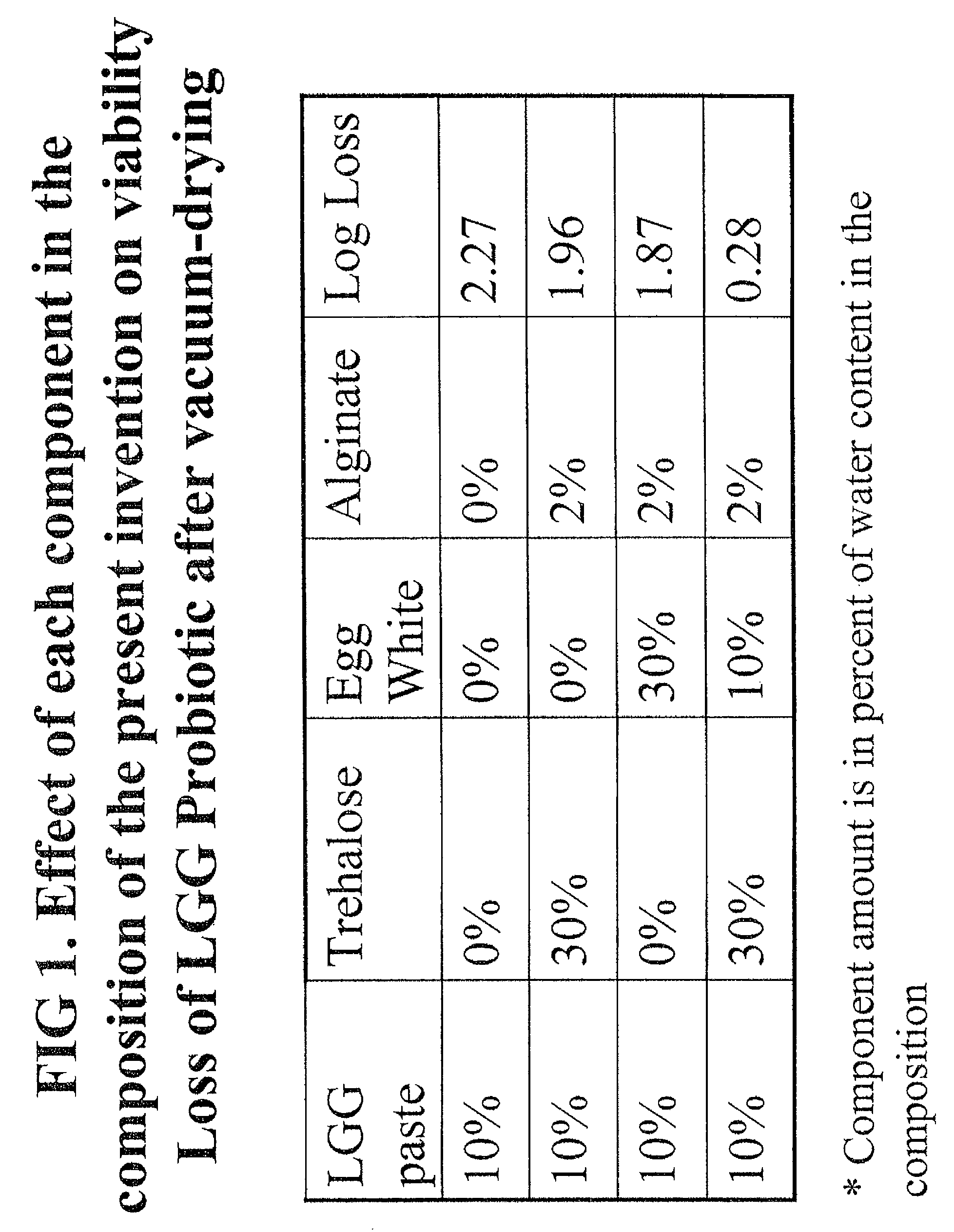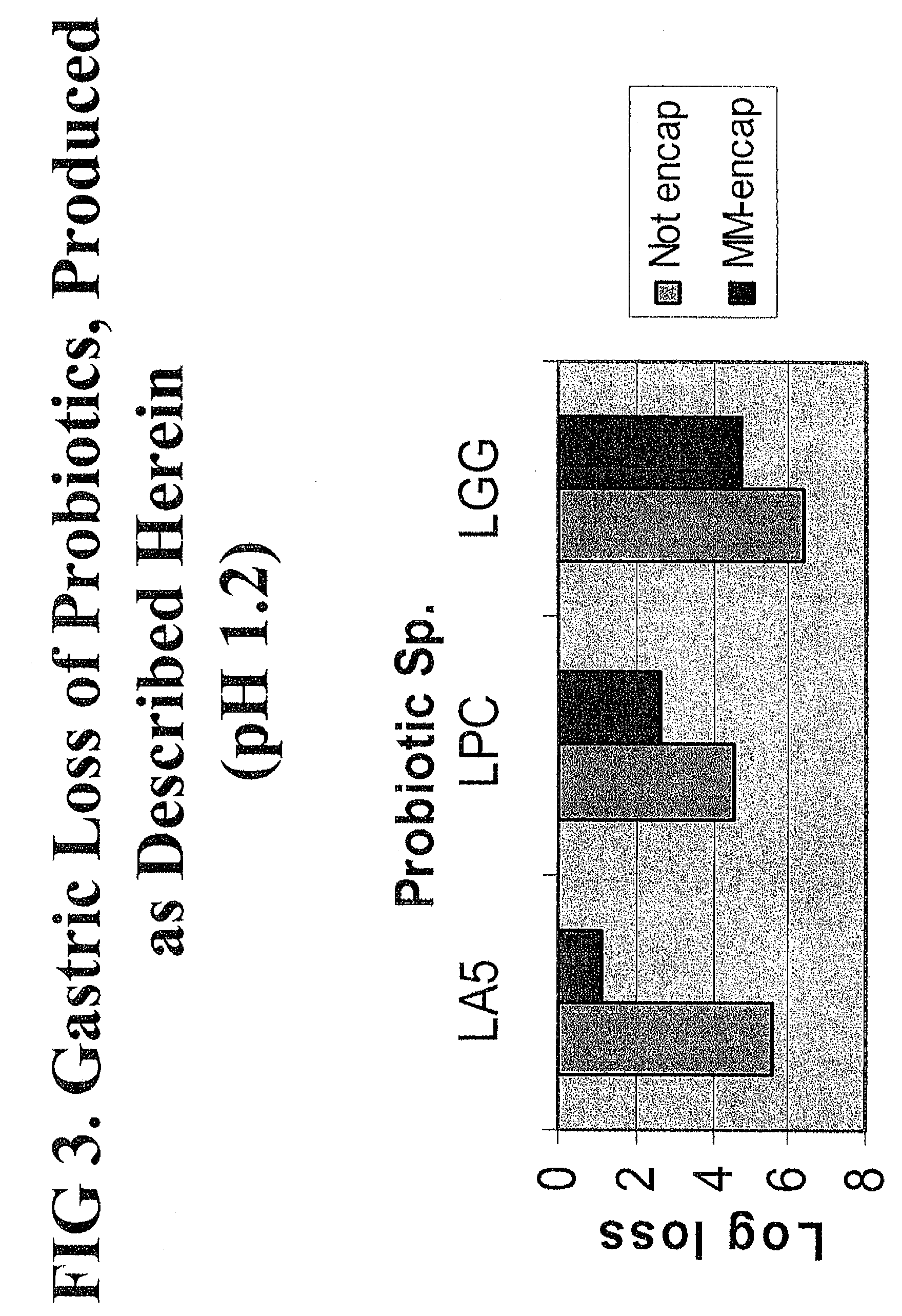Dry food product containing live probiotic
a technology of probiotics and food products, applied in the field of probiotics and food, can solve the problems of significant activity loss, mechanical, chemical, manufacturing food or feedstuffs with live cell organisms or probiotics, etc., and achieve the effect of improving the quality of life and reducing the risk of diseas
- Summary
- Abstract
- Description
- Claims
- Application Information
AI Technical Summary
Benefits of technology
Problems solved by technology
Method used
Image
Examples
example 1
Preparation of Dry and Stable Probiotic Substance
[0072]Basic Formulation
[0073]300 g of trehalose (Cargill Minneapolis, Minn.) was added to 1000 ml water and allowed to completely dissolve. Soy protein isolate (100 g, Feam Natural Foods, Mequon, Wis.) and soy hydrolysate (20 g, Sigma-Aldrich, St. Louis, Mo.) were added under vigorous mixing using a standard household blender. Sodium alginate (20 g) was then mixed into the slurry and allowed to cool down to room temperature. Lactobacillus paracasei (100 g frozen concentrate direct from fermentation harvest) was then added to the slurry under vigorous mixing until a smooth and uniform thick gel was achieved. The composition of the hydrogel is provided in Table 1.
[0074]
TABLE 1Hydrogel composition (g dry weight / 100 ml water)Trehalose30 gSoy protein isolate10 gSoy protein, hydrolysate 2 gSodium Alginate 2 gL. paracasei paste10 g
[0075]Production of Probiotic Flakes
[0076]Five grams of calcium phosphate dibasic was mixed in the basic formula...
example 2
Preparation of Probiotic Pet Food
[0093]Pet food for dogs that is commercially available was first dried in a convection oven to a water activity of 0.1, and then coated with probiotic micromatrix particles in a drum tumbler. The pellets were first sprayed with about 5% of fat-based moisture barrier (a mixture of 40% chicken fat, 40% cocoa butter and 20% beeswax), then mixed with the micro matrix particles (usually 0.1-0.5% of total pet food that provides a dosage of 108 CFU / g) and finally sprayed with additional coat of the fat-based moisture barrier. The total amount of coating was about 15% (of the pet food). Coating time was about 30 minutes.
example 3
Preparation of Fish Feed with Several Probiotic Micro-Organisms
[0094]Pelleted feed for fish was prepared with a mixture of several probiotics. Probiotic micromatrix particles containing a mixture of L. rhamnosus, L. acidophilus and Bifidobacterium lactis (DSM 20215) were prepared as described in Example 1. Fish feed that is commercially available was first dried in a convection oven to a water activity of 0.1, and then coaled with probiotics micromatrix particles in a drum tumbler. The pellets were first sprayed with about 5% of fat-based moisture barrier (a mixture of 40% fish oil, 40% cocoa butter and 20% beeswax), then mixed with the micro matrix particles (usually 0.1-0.5% of total fish feed that provides a dosage of 107 cfu / g) and finally sprayed with additional coat of the fat-based moisture barrier. The total amount of coating was about 10% (of the fish feed).
PUM
 Login to View More
Login to View More Abstract
Description
Claims
Application Information
 Login to View More
Login to View More - R&D
- Intellectual Property
- Life Sciences
- Materials
- Tech Scout
- Unparalleled Data Quality
- Higher Quality Content
- 60% Fewer Hallucinations
Browse by: Latest US Patents, China's latest patents, Technical Efficacy Thesaurus, Application Domain, Technology Topic, Popular Technical Reports.
© 2025 PatSnap. All rights reserved.Legal|Privacy policy|Modern Slavery Act Transparency Statement|Sitemap|About US| Contact US: help@patsnap.com



